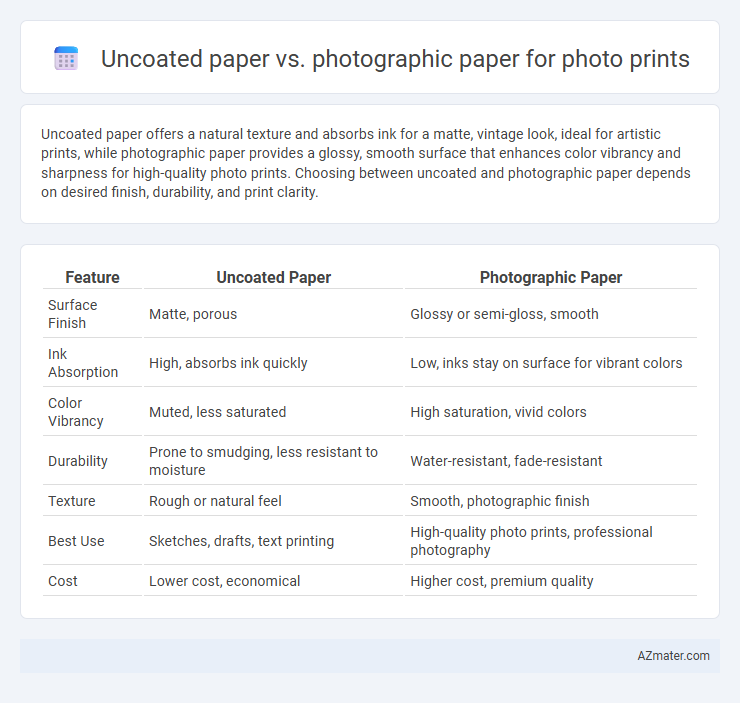Uncoated paper offers a natural texture and absorbs ink for a matte, vintage look, ideal for artistic prints, while photographic paper provides a glossy, smooth surface that enhances color vibrancy and sharpness for high-quality photo prints. Choosing between uncoated and photographic paper depends on desired finish, durability, and print clarity.
Table of Comparison
| Feature | Uncoated Paper | Photographic Paper |
|---|---|---|
| Surface Finish | Matte, porous | Glossy or semi-gloss, smooth |
| Ink Absorption | High, absorbs ink quickly | Low, inks stay on surface for vibrant colors |
| Color Vibrancy | Muted, less saturated | High saturation, vivid colors |
| Durability | Prone to smudging, less resistant to moisture | Water-resistant, fade-resistant |
| Texture | Rough or natural feel | Smooth, photographic finish |
| Best Use | Sketches, drafts, text printing | High-quality photo prints, professional photography |
| Cost | Lower cost, economical | Higher cost, premium quality |
Understanding Uncoated Paper and Photographic Paper
Uncoated paper, known for its porous texture, absorbs ink deeply, resulting in a matte finish that reduces glare and enhances text readability but offers less vibrant color reproduction compared to photographic paper. Photographic paper features a light-sensitive coating that produces high-gloss or satin finishes, delivering sharp, vivid images with rich color depth and superior contrast ideal for detailed photo prints. Understanding the differences in surface texture, ink absorption, and color vibrancy helps determine the best choice for photo printing based on desired visual effect and print durability.
Key Differences in Material Composition
Uncoated paper for photo prints is typically made from natural fibers without any surface coating, resulting in a matte finish that absorbs ink deeply and offers a more textured feel. Photographic paper features a special light-sensitive emulsion layer or a microporous coating that enhances color vibrancy, sharpness, and glossiness, providing richer image quality. The key difference in material composition lies in the presence of this coating on photographic paper, which prevents ink absorption and increases durability compared to uncoated paper.
Image Quality: Sharpness and Color Reproduction
Photographic paper offers superior image quality with enhanced sharpness and vibrant color reproduction due to its specialized coatings designed for ink absorption and light reflection. Uncoated paper lacks these coatings, resulting in softer image details and muted colors that may appear dull or washed out. Choosing photographic paper ensures crisp edge definition and rich, accurate hues essential for premium photo prints.
Texture and Finish: Matte vs Gloss
Uncoated paper offers a natural, matte texture with a soft finish that reduces glare and enhances subtle detail, making it ideal for artistic or vintage-style photo prints. Photographic paper typically features a smooth, glossy finish that intensifies color vibrancy and sharpness, providing a polished look that highlights contrast and depth. Choosing between matte uncoated and glossy photographic paper depends on desired aesthetic effects and display conditions, emphasizing texture and finish as key factors in print quality.
Durability and Longevity of Prints
Uncoated paper tends to have lower durability and longevity compared to photographic paper, as it lacks specialized coatings that resist moisture, fading, and UV damage. Photographic paper is engineered with protective layers that enhance print longevity, often preserving image quality for decades under optimal conditions. For archival purposes and high-quality photo prints, photographic paper is the preferred choice due to its superior resistance to environmental factors and color degradation.
Suitability for Various Printing Methods
Uncoated paper offers versatility for inkjet and laser printers, providing a matte finish ideal for text-heavy prints and softer images but may lack the vibrancy needed for photographic detail. Photographic paper is specifically designed for inkjet photo printers, featuring a coated surface that enhances color saturation and sharpness, making it the preferred choice for high-resolution photo prints. While uncoated papers perform well in multi-purpose printing, photographic paper excels in capturing fine photographic details with superior color fidelity and gloss.
Cost Comparison: Budget Considerations
Uncoated paper generally offers a more budget-friendly option for photo printing, with prices significantly lower than photographic paper due to simpler manufacturing processes. Photographic paper, designed for high-resolution and vibrant color reproduction, tends to be more expensive but justifies the cost with superior print quality and durability. For large volume or casual photo printing, uncoated paper reduces overall expenses, while photographic paper is preferred when print longevity and professional finish are priorities.
Sustainability and Environmental Impact
Uncoated paper is more sustainable than photographic paper due to its minimal chemical processing and easier recyclability, resulting in a lower environmental footprint. Photographic paper often contains plastic coatings and chemicals such as silver halide, which complicate recycling and increase landfill waste and pollution risks. Choosing uncoated paper for photo prints reduces energy consumption and toxic emissions associated with production and disposal, aligning better with eco-friendly printing practices.
Best Uses: When to Choose Each Type
Photographic paper is the best choice for high-quality photo prints requiring vibrant colors and sharp detail, ideal for professional portfolios and fine art photography. Uncoated paper suits casual or artistic prints where texture and a matte finish are desired, such as invitations or vintage-style photos. Selecting photographic paper guarantees enhanced color accuracy and gloss, while uncoated paper offers a tactile, muted appearance perfect for creative presentations.
Final Verdict: Which Paper is Right for Your Photo Prints?
Uncoated paper offers a natural texture and is ideal for matte, artistic photo prints that emphasize subtle details and softer colors, making it suitable for casual or creative projects. Photographic paper, specifically designed for photo printing, provides vibrant colors, sharp details, and a glossy or semi-gloss finish, perfect for high-quality, professional-grade image reproduction. Choosing the right paper depends on your desired aesthetic and print quality: use photographic paper for vivid, museum-quality prints and uncoated paper for a more organic, tactile feel.

Infographic: Uncoated paper vs Photographic paper for Photo print
 azmater.com
azmater.com